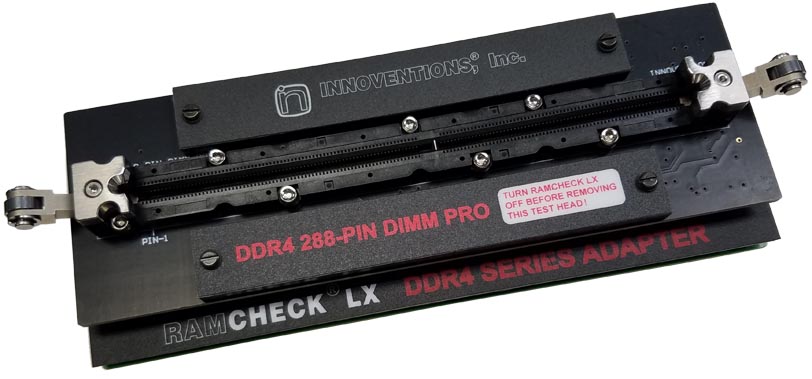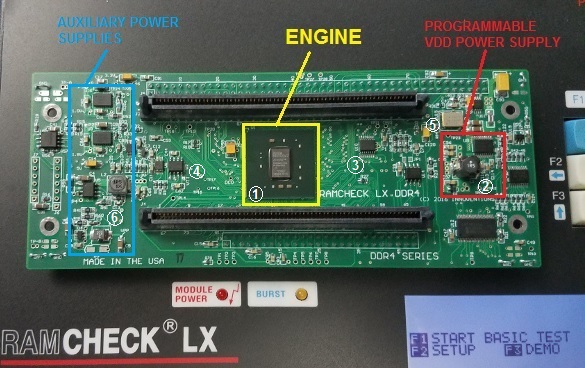

Introducing the RAMCHECK LX DDR4 Pro Adapter
Your best option if you need to test a large volume of memory! The RAMCHECK LX DDR4 Pro 288-pin DIMM Adapter (p/n INN-8686-18-PRO) gives RAMCHECK LX users the power to test 288-pin DDR4 modules, including unbuffered (UDIMM), load-reduced (LRDIMM) and registered modules (RDIMM), both ECC and non-ECC, that comply with JEDEC standards. (Hybrid media like NVDIMM are not supported.) It includes the DDR4 Series adapter and DDR4 Pro DIMM test head.

The DDR4 Pro adapter uses the existing RAMCHECK LX base tester, making it a very cost-effective solution for testing large volumes of DDR4 modules. In fact, its features are what you would expect to find in test equipment that costs many thousands of dollars more.
NOTE: The DDR4 Pro Series adapter will not work with the older RAMCHECK base tester p/n INN-8668. However, we do offer a low-cost factory conversion for RAMCHECK to RAMCHECK LX, so your investment in the older RAMCHECK is not obsolete.
Don't let the adapter's small size fool you! High speed operations require short connections, while the adapter is loaded with state-of-the-art electronic components.
No special setup is required. As with all of our products, the adapter is extraordinarily simple to use. Insert the adapter, turn the RAMCHECK LX tester on, place a module into the test socket, then press the start button.
The new DDR4 288-pin DIMM PRO Test Head (p/n INN-8686-18-8) is included with the DDR4 Pro adapter. It features an extremely rugged high-volume Low-Insertion-Force (LIF) socket. When the socket becomes worn out, the user can purchase a replacement test socket and install it in the field, or return the test head to the factory for socket replacement. Please carefully review the 288-pin DIMM PRO Test Head handling instructions to extend the life of the socket.
The RAMCHECK LX DDR4 Pro Series adapter includes many new features which are relevant to the major differences between DDR4 technology and the older DDR3/2/1 technology.

| 1. | Main engine featuring our improved 1600MHz test engine. |
| 2. | High efficiency switching power regulator to generate the DDR4 VDD at digitally-controlled high resolution. Significantly higher current consumption is supported compared to our previous DDR3 adapter. |
| 3. | Advanced analog section for measuring the module's current, voltages and the board's temperature. |
| 4. | Digitally-controlled Vtt and Vref regulators. |
| 5. | 1333MHz-1600MHz DDR4 clock generator. |
| 6. | Auxiliary power supplies provide highly-efficient voltage sources for the engine and for VPP and VDDSPD. |
As with all of our other RAMCHECK LX adapters, each module's size, structure, and type are automatically detected, without the need for user's setup. The test flow follows our standard Basic Test, Extensive Test, and Auto-Loop process. The RAMCHECK LX DDR4 Pro Series adapter is very simple to operate, with little training required.
 |
The RAMCHECK LX automatically recognized by the DDR4 Series adapter. Seen here is the startup screen once the RAMCHECK LX DDR4 tester is turned on. |

|
The DDR4 Pro Series Adapter uses a variety of test heads. Rapidly pressing the ESC button several times brings this screen, showing the test head configuration and the adapter's temperature. |
| Basic Test | |
 |
The Basic Test screen shows the size, test time, speed, voltage, structure, test pattern, the module's rank/bank, CAS Latency and more. In this screen you will see it testing a 2GBx72 ECC Registered module. |
 |
The previous screen showed the standard structure as '2Rx4'. This screen shows the test voltage as 1.20V. The Basic Test screen also shows the time of test, as well as the section of the module currently under test. B1/1 means Rank1, Bank1 in this example. |
 |
The first line of the Basic Test screen shows an animation as the test process scans the memory array. The actual DDR4 Series adapter test is shown below the test animation line. |

|
The RAMCHECK LX tester displays the module manufacturer's official speed rating on the bottom line. The manufacturer will specify the speed rating based upon expensive and very complex certifying test equipment. Here is another module which is specified for 2400MHz. |
 |
This screen shows another module undergoing test, this time an Unbuffered 1Gx72 ECC DIMM. The current pattern is "AAAAAAA" while the pattern shown in the previous screens was "5555555". |
 |
This screen shows the test of a large 32GB DDR4 module. It is a Registered 4Gx72 ECC DIMM. The module consists of two ranks of x4 memory chips (2Rx4 structure). |
 |
A successful test phase concludes with a clear 'Pass' message as well as sound tones. The important parameters are shown in this screen, which is followed by a detailed test results summary screen. |
| Test Results | |
 |
Test results summary screens provide a wealth of information after each test phase. This screen provides a summary of the module's speed. |
 |
This summary screen includes structure information. The test log includes all of the summary screens. |
 |
The test Log collects and retains all of the intermediary test results, while the memory undergoes all of the test phases. The Test Log remains until a new test is started. Each Test Log can be printed via the USB/PC software interface, and you can also save the file. |
 |
This screen is part of the detailed structure information detected by the RAMCHECK LX. It reports a successful set of connector wiring tests. |
 |
This screen follows the previous one. It shows the module ID (s/n), as well as information about the temperature sensor inside the module's SPD chip. It reports successful address wiring tests in ranks 1 and 2. |
 |
This screen shows the final temperature during the Basic Test, as well as the timer reading. It also lists the manufacturer's speed rating. |
 |
Displayed is the size data captured for a large 32GB DDR4 module. This 4GBx72 2Rx4 module uses 2Gx4 DDR4 memory chips, with 16 banks and 17 row/10 column addressing. |
| Extensive Test | |
 |
The EXTENSIVE Test performs a number of tests to determine the quality of the memory. |
 |
VOLTAGE CYCLING performs tests under allowable voltage deviations from the recommended VDD setting. |
 |
VOLTAGE BOUNCE tests data retention during voltage variations between read and write. For DDR4, bouncing is done between 1.14V to 1.26V, spanning the recommended VDD range. |
 |
CHIP HEAT MODE tests at elevated operating temperatures. This module is tested at the top recommended voltage for DDR4 (1.26V), while the program exercises all of the module's ranks. |
 |
The FINAL TEST repeats the general Basic Test at the end of the Extensive Test flow. |
 |
A successful Extensive Test concludes with a clear 'Pass' message and unique tones. The important parameters are shown in this screen. |
 |
TEST LOG The Test Log lists the results of all the phases of the Extensive Test. |
 |
In this screen, the Test Log completes listing the results of all the phases of the Extensive Test. |
| Auto Loop | |
 |
AUTO LOOP tests memory with endless pattern changes. It's great for burn-in testing. |
 |
The AUTO-LOOP screen indicates the current loop number and the first data of the current complex pattern. The "8A8A8A8A" hex marker is duplicated for the full 64/72 bit extended word. |
 |
The AUTO-LOOP automatically cools down the tested module every 16 loops, so that the module's operation is checked with a changing temperature gradient. Other functions like self refresh or CKE controlled power down mode are exercised. |
| Change-on-the-fly and Setup | |
 |
Expanded CHANGE-ON-THE-FLY can be used to set up the Frequency, Voltage, CAS LATENCY and the Refresh rate only for the current test. Following the current test, it returns to the current setup parameters. |
 |
CAS Latency can be set at 9-24. The write CAS Latency (CWL) is dependent on the read CL, as shown. Please note that not all DDR4 modules support all CL values. |
 |
The DDR4 VDD Voltage setup allows the user to change the test voltage in the range 1.14V-1.26V "on-the-fly." When set to AUTO, RAMCHECK LX automatically tests the module at 1.20V. In this example, the user selects a VDD of 1.24 Volt. |
| Wiring Errors Detection | |
 |
DDR4 devices utilize the differential DQS technique, which assigns a pair of two control lines per each DQS. In this example, DQS0 line (pin 153) was stuck at 0. |
 |
Address lines errors in the DDR4 modules are reported explicitly in this example. Here address line A9 (pin 66) is shorted to ground. |
 |
Data line errors in DDR4 modules are reported explicitly as shown in this example. Here data line D30 (pin 43) is shorted to VDD. |
 |
The DDR4 module uses ODT control lines to activate the internal Rtt termination resistors. In this test error example, line ODT1 (pin 91) is shorted to ground. |
| SPD Editor | |
 |
The device's SPD can be conveniently viewed, edited and programmed on the RAMCHECK LX. You can also use the advanced SPD features in the PC RAMCHECK LX communications program. |
The RAMCHECK LX DDR4 Pro adapter can perform DDR4 tests at actual test frequencies up to 1600MHz. All DDR4 Modules designed for higher frequencies (DDR4-3200, DDR4-2666, DDR4-2400, DDR4-2133 and DDR4-1866) can be functionally tested on the DDR4 Series adapter but at a reduced frequency.
We are developing additional test heads for the DDR4 series:
Note: The DDR4 Pro Series adapter only works with the RAMCHECK LX. It does not work with our prior-generation RAMCHECK base tester. If you own the older RAMCHECK tester, please contact us for conversion or trade-in offers, or call INNOVENTIONS at 1 (281) 879-6226. When ordering, please reference part number INN-8686-18-PRO.

 Click here
for RAMCHECK LX DDR4 brochure. (PDF file)
Click here
for RAMCHECK LX DDR4 brochure. (PDF file)